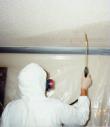WHAT IS ASBESTOS
Asbestos is a naturally occurring fibrous mineral (magnesium silicate) that can
be found in six different forms; chrysotile, amosite, crocidolite,
anthophyllite, tremolite and actinolite. The first three are the most common
and are also known as White, Brown or Blue asbestos respectively.
[ Back to the top ]
WHY WAS ASBESTOS USED?
Asbestos is light, strong, does not bum, does not conduct heat or electricity, is very resistant to chemicals, and is
fibrous. These properties made it something of a wonder material in the 1950s
because of its many potential uses. It was used extensively up to 1985 in heat
and electrical insulation products (including sprays, insulation boarding and
lagging) and up to 1999 as a bonding and strengthening agent in building
materials (cement board, rainwater goods, floor tiles, roof tiles, stair
nosing, textured paint coating).
does not conduct heat or electricity, is very resistant to chemicals, and is
fibrous. These properties made it something of a wonder material in the 1950s
because of its many potential uses. It was used extensively up to 1985 in heat
and electrical insulation products (including sprays, insulation boarding and
lagging) and up to 1999 as a bonding and strengthening agent in building
materials (cement board, rainwater goods, floor tiles, roof tiles, stair
nosing, textured paint coating).
It was also commonly used in sink pads (for acoustics), resins, plastics (such
as toilet cisterns), brake pads, fuse flashguards, firesafe linings, paint,
textiles (such as fire blankets), felt, rope, paper, mattresses and gaskets.
[ Back to the top ]
WHY IS ASBESTOS DANGEROUS
Asbestos fibres are occasionally small enough to pass into the lungs and
because of its ‘wonder’ properties are resistant to the normal defence
processes taking place in the human body and so it remains in the lung, often
entering the lining. Over time this can cause lung diseases such as
asbestosis, mesothelioma (a cancer affecting the lining of the lung
cavity), lung cancer and pleural thickening (thickening of the lining of the
lung cavity).
According to the HSE website at least 3,500 people die annually as a result of
exposure to asbestos.
[ Back to the top ]
IS ASBESTOS LIKELY TO BE IN MY PROPERTY?
If your house or workplace was built or last refurbished before 1985 there is a
good chance that one of the products listed above will be present especially if
you have an old heating system.
Houses or workplaces built or refurbished after 1985 may contain cement or
textured coating.
[ Back to the top ]
SHOULD I BE WORRIED?
As we have outlined above, asbestos is hazardous if its fibres enter the lungs.
Therefore it is only dangerous if asbestos fibres are likely to be released
into the air and inhaled. Asbestos cement, stair nosing, floor tiles and other
such composite materials are unlikely to release fibres without being very
badly damaged. However, insulation products such as lagging, sprays and
Asbestos Insulation Board (AIB) are less compact and will typically release
fibres more easily. These products should be treated with great care and if
they are damaged (or are likely to be) you should take action.
[ Back to the top ]
WHAT SHOULD I DO IF I THINK I HAVE DANGEROUS ASBESTOS IN MY PROPERTY
The first thing to do is isolate the area in which you’ve discovered the
suspect material. If this is not possible then you
 should restrict access to the area as
much as possible. Secondly you should get a sample taken and tested. Typically
this will cost around £100 and we recommend that you use either a licensed
contractor or a UKAS accredited surveying company.
should restrict access to the area as
much as possible. Secondly you should get a sample taken and tested. Typically
this will cost around £100 and we recommend that you use either a licensed
contractor or a UKAS accredited surveying company.
If the sample results indicate the presence of asbestos and the material is
damaged sufficiently to be a risk then you should aim to remove or repair the
material. The Asbestos (Licensing) Regulations 1983 govern whether or not you
need to use a licensed contractor to carry out these actions.
MORE INFORMATION
http://www.hse.gov.uk/contact/faqs/asbestoslicence.htm
http://www.hse.gov.uk/contact/faqs/cement.htm
[ Back to the top ]
ARE SOME TYPES OF ASBESTOS MORE DANGEROUS THAN OTHERS
Yes. As we’ve already outlined, certain products tend to be more hazardous than
others because of the likelihood of them releasing fibres but different
asbestos types are also more dangerous than others. The most dangerous are
crocidolite (blue asbestos) and amosite (brown asbestos) which tend to be the
types used in insulation products. The least hazardous is chrysotile (white
asbestos) which is mostly commonly found in composite and cement materials.
[ Back to the top ]
WHAT IS THE GOVERNMENT DOING TO PROTECT PEOPLE FROM ASBESTOS EXPOSURE?
The UK government have developed the Control of Asbestos Regulations 2006
to protect workers from the hazard of asbestos. Essentially the dutyholder at
every commercial property must;
-
Establish the location and condition of any asbestos containing materials
(ACMs) within properties under their control (normally done by a survey).
-
Hold and maintain a register of all ACMs
-
Prepare a management plan to carry out any actions that are necessary to
prevent exposure to the fibres.
-
Carry out the actions in the plan.
-
Periodically review the status of their ACMs against their register and make
any necessary amendments.
For more details on the duty to manage you can visit the HSE website at
http://www.hse.gov.uk/campaigns/asbestos/duty.htm
[ Back to the top ]
HOW CAN ACM MANAGER HELP?
ACM Manager is an online set of software tools that simplifies the processes
required to comply with the Control of Asbestos Regulations 2006. It makes
asbestos management considerably easier by automating and simplifying some of
the more complex tasks such as maintaining asbestos registers and action plans.
More details can be found on our product details page.
[ Back to the top ]